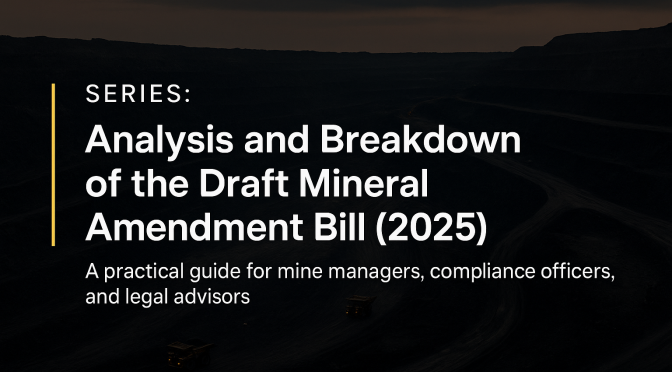The Draft Mineral Resources Development Amendment Bill (2025) represents the most substantial proposed reform of South Africa’s mineral legislation since the enactment of the Mineral and Petroleum Resources Development Act (MPRDA) in 2002. Gazetted on 20 May 2025, the Bill introduces a series of amendments aimed at consolidating transformation objectives, tightening compliance obligations, and embedding sustainable development principles more deeply into the regulatory framework.
While the MPRDA has served as the central statute governing mineral rights for over two decades, its implementation has been marked by periodic amendments, evolving Mining Charters, and persistent legal uncertainty. Disputes over the status of the Mining Charter and the unresolved interpretation of the “once empowered, always empowered” principle have contributed to a fragmented compliance environment. The Draft Bill responds to these issues by elevating several policy-driven commitments into binding statutory provisions, signalling a shift toward more prescriptive and enforceable obligations across the sector.
Background and Rationale
The intention behind the Draft Bill is to provide clarity where policy instruments have proven vulnerable to legal challenge and administrative inconsistency. In particular, the Bill proposes that broad-based black economic empowerment (B-BBEE), beneficiation obligations, and community development commitments be positioned as express conditions of mining rights, removing the scope for discretionary enforcement and varied interpretation. This approach reflects a policy judgement that transformation objectives require a firmer legal footing to achieve meaningful implementation.
Key Features of the Draft Bill
The proposed amendments include a set of new and amended definitions, such as “artisanal mining permit,” “associated mineral,” and “security of supply,” designed to align the Act’s terminology with other legislation and contemporary sector realities. Clause 53 amends section 100 of the MPRDA by reinforcing the Minister’s duty to develop a binding B-BBEE Charter that will function as an instrument of transformation with statutory effect. This will likely intensify the focus on empowerment compliance as a non-negotiable condition of mining rights.
Clauses 51 and 52 introduce enforceable obligations for Social and Labour Plans (SLPs), providing that failure to deliver on community development commitments can result in ministerial directives, suspension of rights, or remedial enforcement. The Bill also expands the Minister’s discretion to impose beneficiation requirements, strengthening policy levers to promote domestic value addition. Clause 54 inserts a new section 100A, which establishes penalties of up to ten million rand in fines or ten years’ imprisonment for contraventions of the Act or non-compliance with the conditions of a mining right. In parallel, provisions on closure and rehabilitation are tightened to ensure that environmental and post-mining responsibilities are adequately funded and monitored over the life of the project.
Beyond these substantive obligations, the Bill increases the administrative powers available to the Minister, including the authority to issue compliance directives and recover the costs of remediation where rights holders fail to act. The cumulative effect is a framework where compliance is more explicitly measurable and directly enforceable.
Why This Matters
If adopted in its current form, the Draft Mineral Amendment Bill will transform the compliance landscape for mining companies operating in South Africa. Obligations previously regarded as policy undertakings will become enforceable legal duties, with significant penalties attached to non-performance. For boards, executives, and operational managers, this creates an imperative to integrate transformation, SLP delivery, and beneficiation obligations into the same governance structures that manage safety and environmental compliance. The regulatory expectations for evidencing delivery and maintaining auditable records will increase correspondingly.
Questions to Consider
Which parts of your current operations and reporting processes are most exposed to the Draft Bill’s proposed requirements? How will you demonstrate verifiable compliance if B-BBEE and SLP obligations become statutory conditions of mining rights? What timelines and budgets will be required to adapt governance, monitoring, and assurance processes to the standards envisaged in the Bill?
If you would like to explore these provisions in more detail or need support preparing a readiness assessment, feel free to connect or reach out directly.
#Mining #Compliance #SouthAfrica #MiningLaw #Transformation

